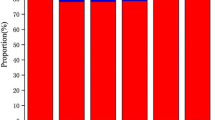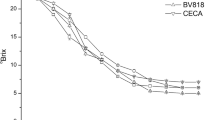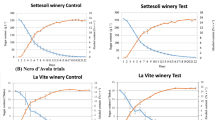Abstract
The production of waxy rice wine (WRW) usually requires multiple strains for fermentation. However, information about the contributions of individual strains to the quality of WRW remains limited. In this study, WRWs were produced through fermentation with three strains (Saccharomyces cerevisiae H1 [Sc], Hansenula sp. H3 [Hs] and Pichia kudriavzevii H6 [Pk]), and the quality of the WRWs was evaluated. The results indicated that Sc wine produced high levels of phenylethyl alcohol and 3-methyl-1-butyl acetate, reaching 31,622.78 μg/L and 351.67 μg/L, respectively; Hs wine produced the highest contents of ethyl acetate and lactic acid, reaching 69,535.58 μg/L and 17.46 g/L, respectively, and had the highest score for “acidic”; Pk wine produced high contents of 2-methyl-1-propanol, 3-methyl-1-butanol and 2-methyl-1-butanol, reaching 46,951.56 μg/L, 163,674.83 μg/L and 52,238.51 μg/L, respectively. The average concentrations of ethyl acetate, 2-methyl-1-propanol, and 3-methyl-1-butanol in mixed fermentation products increased by 126.80%, 25.82% and 17.02% compared to Sc wine, respectively, thus increasing the sensory scores for “malty” and “acidic”. In addition, high ethanol content resulted in higher scores for “winey” in WRWs. These results reveal the potential of S. cerevisiae H1 to produce ethanol, Hansenula sp. H3 to produce esters and P. kudriavzevii H6 to produce alcohols in WRW. Simultaneously, advantages of mixed fermentation for integrating the characteristics of various pure cultures were observed, namely increasing the number of volatile organic compounds (VOCs) and appropriately extending the fermentation time. The application of mixed fermentation has the potential to enrich the flavour and improve the quality of WRWs.
Graphical abstract





Similar content being viewed by others
Data availability
All data generated or analysed during this study are included in this published article.
References
Yang Y, Hu W, Xia Y et al (2020) Flavor formation in Chinese rice wine (Huangjiu): impacts of the flavor-active microorganisms, raw materials, and fermentation technology. Front Microbiol 11:580247. https://doi.org/10.3389/fmicb.2020.580247
Varela C, Dry PR, Kutyna DR et al (2015) Strategies for reducing alcohol concentration in wine. Aust J Grape Wine Res 21(1):670–679. https://doi.org/10.1111/ajgw.12187
Yu H, Xie T, Xie J et al (2019) Characterization of key aroma compounds in Chinese rice wine using gas chromatography-mass spectrometry and gas chromatography-olfactometry. Food Chem 293:8–14. https://doi.org/10.1016/j.foodchem.2019.03.071
Yang Y, Xia Y, Wang G et al (2019) Effects of boiling, ultra-high temperature and high hydrostatic pressure on free amino acids, flavor characteristics and sensory profiles in Chinese rice wine. Food Chem 275:407–416. https://doi.org/10.1016/j.foodchem.2018.09.128
Wang X, Tian R, Yang H et al (2022) Effect of baking technique for rice wine production and the characteristics of baked rice wine. J Sci Food Agric 102(4):1498–1507. https://doi.org/10.1002/jsfa.11484
Yang Y, Zhong H, Yang N et al (2022) Effects of the proteins of indica rice and indica waxy rice on the formation of volatiles of sweet rice wine. Int J Food Sci Technol Adv. https://doi.org/10.1111/ijfs.15684 (online publication)
Chen C, Liu Y, Tian H et al (2020) Metagenomic analysis reveals the impact of JIUYAO microbial diversity on fermentation and the volatile profile of Shaoxing-jiu. Food Microbiol 86:103326. https://doi.org/10.1016/j.fm.2019.103326
Chen L, Li D, Ren L et al (2020) Effects of simultaneous and sequential cofermentation of Wickerhamomycesanomalus and Saccharomyces cerevisiae on physicochemical and flavor properties of rice wine. Food Sci Nutr 9(1):71–86. https://doi.org/10.1002/fsn3.1899
Zhu J, Lin JL, Palomec L et al (2015) Microbial host selection affects intracellular localization and activity of alcohol-o-acetyltransferase. Microb Cell Fact 14(1):35. https://doi.org/10.1186/s12934-015-0221-9
Huang ZR, Hong JL, Xu JX et al (2018) Exploring core functional microbiota responsible for the production of volatile flavour during the traditional brewing of wuyi hong qu glutinous rice wine. Food Microbiol 76:487–496. https://doi.org/10.1016/j.fm.2018.07.014
Comitini F, Gobbi M, Domizio P et al (2011) Selected non-Saccharomyces wine yeasts in controlled multistarter fermentations with Saccharomyces cerevisiae. Food Microbiol 28(5):873–882. https://doi.org/10.1016/j.fm.2010.12.001 (450)
Berbegal C, Khomenko I, Russo P et al (2020) PTR-ToF-MS for the online monitoring of alcoholic fermentation in wine: assessment of VOCs variability associated with different combinations of Saccharomyces/non-Saccharomyces as a case-study. Fermentation 6:55. https://doi.org/10.3390/fermentation6020055
Ciani M, Beco L, Comitini F (2006) Fermentation behaviour and metabolic interactions of multistarter wine yeast fermentations. Int J Food Microbiol 108(2):239–245. https://doi.org/10.1016/j.ijfoodmicro.2005.11.012
Satora P, Semik-Szczurak D, Tarko T et al (2018) Influence of selected Saccharomyces and Schizosaccharomyces strains and their mixed cultures on chemical composition of apple wines. J Food Sci 83(2):424–431. https://doi.org/10.1111/1750-3841.14042
Aplin JJ, Edwards CG (2021) Impacts of non-Saccharomyces species and aeration on sequential inoculation with Saccharomyces cerevisiae to produce lower alcohol Merlot wines from Washington state. J Sci Food Agric 101(4):1715–1719. https://doi.org/10.1002/jsfa.10769
Maria T, Mariagiovanna F, Joana P et al (2021) Influence of non-Saccharomyces on wine chemistry: a focus on aroma-related compounds. Molecules 26(3):644. https://doi.org/10.3390/molecules26030644
Anfang N, Brajkovich M, Goddard MR (2009) Co-fermentation with Pichia kluyveri increases varietal thiol concentrations in Sauvignon Blanc. Aust J Grape Wine Res 15:1–8. https://doi.org/10.1111/j.1755-0238.2008.00031.x
He WJ, Liu SX, Heponiemi P et al (2021) Effect of Saccharomyces cerevisiae and Schizosaccharomyces pombe strains on chemical composition and sensory quality of ciders made from Finnish apple cultivars. Food Chem 345:128833. https://doi.org/10.1016/j.foodchem.2020.128833
Wang P, Mao J, Meng X et al (2014) Changes in flavour characteristics and bacterial diversity during the traditional fermentation of Chinese rice wines from Shaoxing region. Food Control 44:58–63. https://doi.org/10.1016/j.foodcont.2014.03.018
Ji ZW, Jin JS, Yu GS et al (2018) Characteristic of filamentous fungal diversity and dynamics associated with wheat Qu and the traditional fermentation of Chinese rice wine. Int J Food Sci Technol 53(7):1611–1621. https://doi.org/10.1111/ijfs.13743
Min G, Zhou Z, Jin J et al (2020) Effects of soaking on physicochemical properties of four kinds of rice used in Huangjiu brewing. J Cereal Sci 91:102855. https://doi.org/10.1016/j.jcs.2019.102855
Liu C, Li M, Ren T et al (2022) Effect of Saccharomyces cerevisiae and non-Saccharomyces strains on alcoholic fermentation behavior and aroma profile of yellow-fleshed peach wine. LWT Food Sci Technol Adv. https://doi.org/10.1016/j.lwt.2021.112993 (online publication)
Han Y, Du J, Li J et al (2019) Quantification of the organic acids in hawthorn wine: a comparison of two HPLC methods. Molecules (Basel, Switzerland) 24(11):2150. https://doi.org/10.3390/molecules24112150
Wang J, Ming Y, Li Y et al (2021) Characterization and comparative study of the key odorants in Caoyuanwang mild-flavor style Baijiu using gas chromatography-olfactometry and sensory approaches. Food Chem 347:129028. https://doi.org/10.1016/j.foodchem.2021.129028
Alvarez MG, Gonzalez-Barreiro C, Cancho-Grande B et al (2011) Relationships between Godello white wine sensory properties and its aromatic fingerprinting obtained by GC-MS. Food Chem 129(3):890–898. https://doi.org/10.1016/j.foodchem.2011.05.040
De La Fuente BA, Ferreira V (2020) Gas chromatography olfactometry (GC-O) for the (semi) quantitative screening of wine aroma. Foods (Basel, Switzerland) 9(12):1892. https://doi.org/10.3390/foods9121892
Lan Y, Guo J, Qian X et al (2021) Characterization of key odor-active compounds in sweet Petit Manseng (Vitis vinifera L.) wine by gas chromatography-olfactometry, aroma reconstitution, and omission tests. J Food Sci 86(4):1258–1272. https://doi.org/10.1111/1750-3841.15670
Kaneko S, Kumazawa K (2015) Aroma compounds in Japanese sweet rice wine (Mirin) screened by aroma extract dilution analysis (AEDA). Biosci Biotechnol Biochem 79(3):484–487. https://doi.org/10.1080/09168451.2014.980218
Zhu LX, Zhang MM, Xiang XF et al (2021) Aromatic characterization of traditional Chinese wine Msalais by partial least-square regression analysis based on sensory quantitative descriptive and odor active values, aroma extract dilution analysis, and aroma recombination and omission tests. Food Chem 361:129781. https://doi.org/10.1016/j.foodchem.2021.129781
Ye Y, Wang L, Zhan P et al (2021) Characterization of the aroma compounds of millet huangjiu at different fermentation stages. Food Chem 366:130691. https://doi.org/10.1016/j.foodchem.2021.130691
Morata A, Escott C, Loira I et al (2019) Influence of Saccharomyces and non-Saccharomyces yeasts in the formation of pyranoanthocyanins and polymeric pigments during red wine making. Molecules 24:4490. https://doi.org/10.3390/molecules24244490
Binati RL, Lemos WJF, Luzzini G et al (2020) Contribution of non-Saccharomyces yeasts to wine volatile and sensory diversity: a study on Lachanceathermotolerans, Metschnikowia spp. and Starmerellabacillaris strains isolated in Italy. Int J Food Microbiol 318:108470. https://doi.org/10.1016/j.ijfoodmicro.2019.108470
Berbegal C, Spano G, Tristezza M et al (2017) Microbial resources and innovation in the wine production sector. S Afr J Enol Vitic 38:156–166. https://doi.org/10.21548/38-2-1333
Liu SX, Laaksonen O, Kortesniemi M et al (2018) Chemical composition of bilberry wine fermented with non-Saccharomyces yeasts (Torulasporadelbrueckii and Schizosaccharomyces pombe) and Saccharomyces cerevisiae in pure, sequential and mixed fermentations. Food Chem 266:262–274. https://doi.org/10.1016/j.foodchem.2018.06.003
Capozzi V, Berbegal C, Tufariello M et al (2019) Impact of co-inoculation of Saccharomyces cerevisiae, Hanseniaspora uvarum and Oenococcusoeni autochthonous strains in controlled multi starter grape must fermentations. LWT Food Sci Technol 109:241–249. https://doi.org/10.1016/j.lwt.2019.04.045
Chen S, Xu Y (2010) The influence of yeast strains on the volatile flavour compounds of Chinese rice wine. J Inst Brew 116(2):190–196. https://doi.org/10.1002/j.2050-0416.2010.tb00417.x
Luan Y, Zhang B, Duan C et al (2018) Effects of different pre-fermentation cold maceration time on aroma compounds of Saccharomyces cerevisiae co-fermentation with Hanseniaspora opuntiae or Pichia kudriavzevii. LWT-Food Sci Technol 92:177–186. https://doi.org/10.1016/j.lwt.2018.02.004
Gu Y, Ma J, Zhu Y et al (2020) Refactoring ehrlich pathway for high-yield 2-phenylethanol production in Yarrowialipolytica. ACS Synth Biol 9(3):623–633. https://doi.org/10.1021/acssynbio.9b00468
Löser C, Urit T, Bley T (2014) Perspectives for the biotechnological production of ethyl acetate by yeasts. Appl Microbiol Biotechnol 98(12):5397–5415. https://doi.org/10.1007/s00253-014-5765-9
Wang X, Xie K, Zhuang H et al (2015) Volatile flavor compounds, total polyphenolic contents and antioxidant activities of a China gingko wine. Food Chem 182:41–46. https://doi.org/10.1016/j.foodchem.2015.02.120
Dein M, Kerley T (2021) Characterization of odorants in a 10-year-old riesling wine. J Agric Food Chem 69(38):11372–11381. https://doi.org/10.1021/acs.jafc.1c04196
Van Gemert LJ (2011) Odour thresholds. In: Compilations of odour threshold values in air, water and other media, 2nd ed. Oliemans Punter & Partners BV, Oliemans Punter & Partners BV, The Netherlands
Yin M, Shao SJ, Zhou ZL et al (2020) Characterization of the key aroma compounds in dog foods by gas chromatography-mass spectrometry, acceptance test, and preference test. J Agric Food Chem 68(34):9195–9204. https://doi.org/10.1021/acs.jafc.0c03088
Funding
This work was sponsored in part by the science and technology research planning project (JJKH2024) from Jilin provincial department of education, and the scholar climbing project (ZKP202006 and ZKP202016) from Changchun University.
Author information
Authors and Affiliations
Contributions
Conceptualization, funding acquisition, project administration, resources, supervision, validation, and review and editing of the manuscript: DL and XL. Data curation, formal analysis, methodology, software, and drafting of the manuscript: YH, MZ, SM, YH, and YS.
Corresponding authors
Ethics declarations
Conflict of interest
The authors declare that they have no conflict of interest.
Compliance with ethics requirements
This article does not contain any studies with human or animal subjects.
Additional information
Publisher's Note
Springer Nature remains neutral with regard to jurisdictional claims in published maps and institutional affiliations.
Rights and permissions
Springer Nature or its licensor (e.g. a society or other partner) holds exclusive rights to this article under a publishing agreement with the author(s) or other rightsholder(s); author self-archiving of the accepted manuscript version of this article is solely governed by the terms of such publishing agreement and applicable law.
About this article
Cite this article
Huang, Y., Zhong, M., Mu, S. et al. Assessment of the contributions of Saccharomyces cerevisiae, Hansenula sp. and Pichia kudriavzevii to volatile organic compounds and sensory characteristics of waxy rice wine. Eur Food Res Technol 249, 685–697 (2023). https://doi.org/10.1007/s00217-022-04165-x
Received:
Revised:
Accepted:
Published:
Issue Date:
DOI: https://doi.org/10.1007/s00217-022-04165-x




